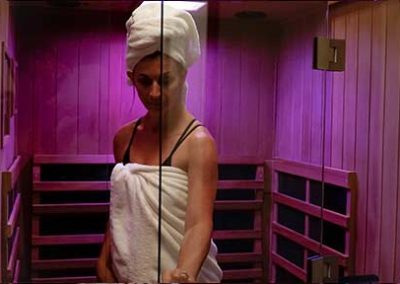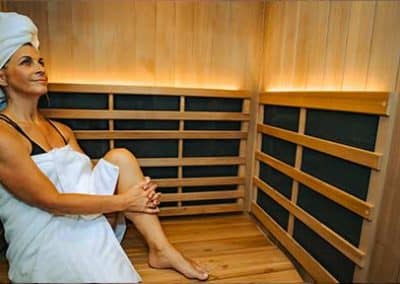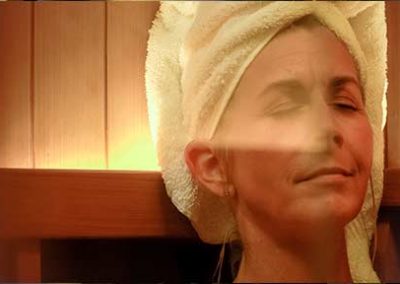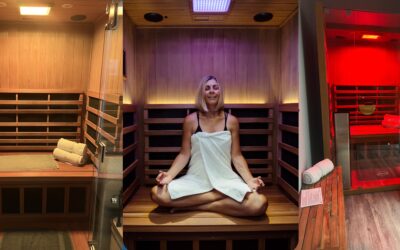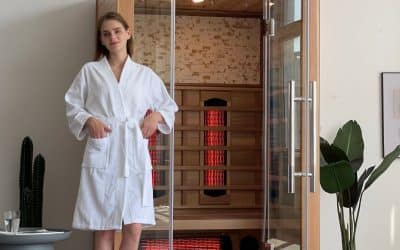Full Spectrum Infrared Sauna
Infrared sauna therapy makes healing relaxing, comfortable, and safe. By increasing your body temperature with infrared light, our sauna helps improve your cardiovascular health, relieve body pains, detoxify, and so much more!
Why Infrared Sauna?
There are countless benefits to infrared (IR) sauna therapy including detoxification, decreased inflammation, increased metabolism, and more! These effects can help improve many chronic conditions as well as symptoms of acute health concerns. Not only does IR sauna therapy improve specific health issues, but it also has immediate relief of day-to-day stress and body aches/pains. So, whether you’re looking for a supplemental therapy for a chronic condition, relief from stress and body pains, or simply a way to detox and relax, IR sauna therapy is for you.

Incredibly relaxing, safe therapy with few common side effects

State of the art, full-spectrum infrared sauna

Helps improve circulation, decrease inflammation, detoxify, and more!
Request More Information:
Who can Infrared Sauna Help?
Infrared saunas can help relieve the symptoms of many health conditions, acute concerns, and general feelings of wellbeing and relaxation.
- Arthritis(16)
- Cardiovascular Disease(20-24)
- Chronic Pain(18-19)
- Diabetes(17)
- Exercise Recovery(29-30)
- Fibromyalgia(34-35)
- Lyme’s Disease(36)
- Neurological Disease(27-28)
- Obesity(15)
- Respiratory Disease(25-26)
- Skin Concerns (pigmentation/aging)(31-33)

How does Infrared Sauna Therapy Work?
You’re probably familiar with traditional saunas if you’ve ever been to a spa or wellness retreat. While traditional saunas can have great stress-relieving benefits, infrared saunas are another type of sauna that can make an even greater impact on your health.
When you are in an infrared sauna, the light energy which it emits increases your body temperature and causes it to enter a state of thermal stress(1). This thermal stress results in number of physiological changes including increased heart rate and blood flow, decreased blood pressure, increased metabolism, muscle relaxation, and release of beneficial hormones(2-7). Such changes can have immediate relief of stress and body aches, as well as improve many of the systems that are impaired in disease.
Our Infrared Sauna
At Extivita, we use a state-of-the-art full spectrum infrared sauna boasting the lowest and safest EMF and ELF levels of any infrared sauna on the market. With 12 different infrared light settings, our sauna offers a personalized experience tailored to meet your unique health needs. While many saunas only use far-infrared wavelengths, ours delivers near-infrared (IR-A), mid-infrared (IR-B) and far-infrared (IR-C) light. By emitting the full infrared spectrum, our sauna penetrates not only the outermost layer of the skin (the epidermis), but the deeper layer of the skin (the dermis) as well(8). Additionally, our sauna delivers over 25 times the power of the nearest clinic’s, allowing for the deepest tissue penetration and optimal health benefits.
What are the Benefits of Infrared Sauna?
While the effects depend on the patient, condition being treated, number and frequency of of treatments. Patients who have received infrared sauna have experienced the following benefits in as little as 10 sessions:
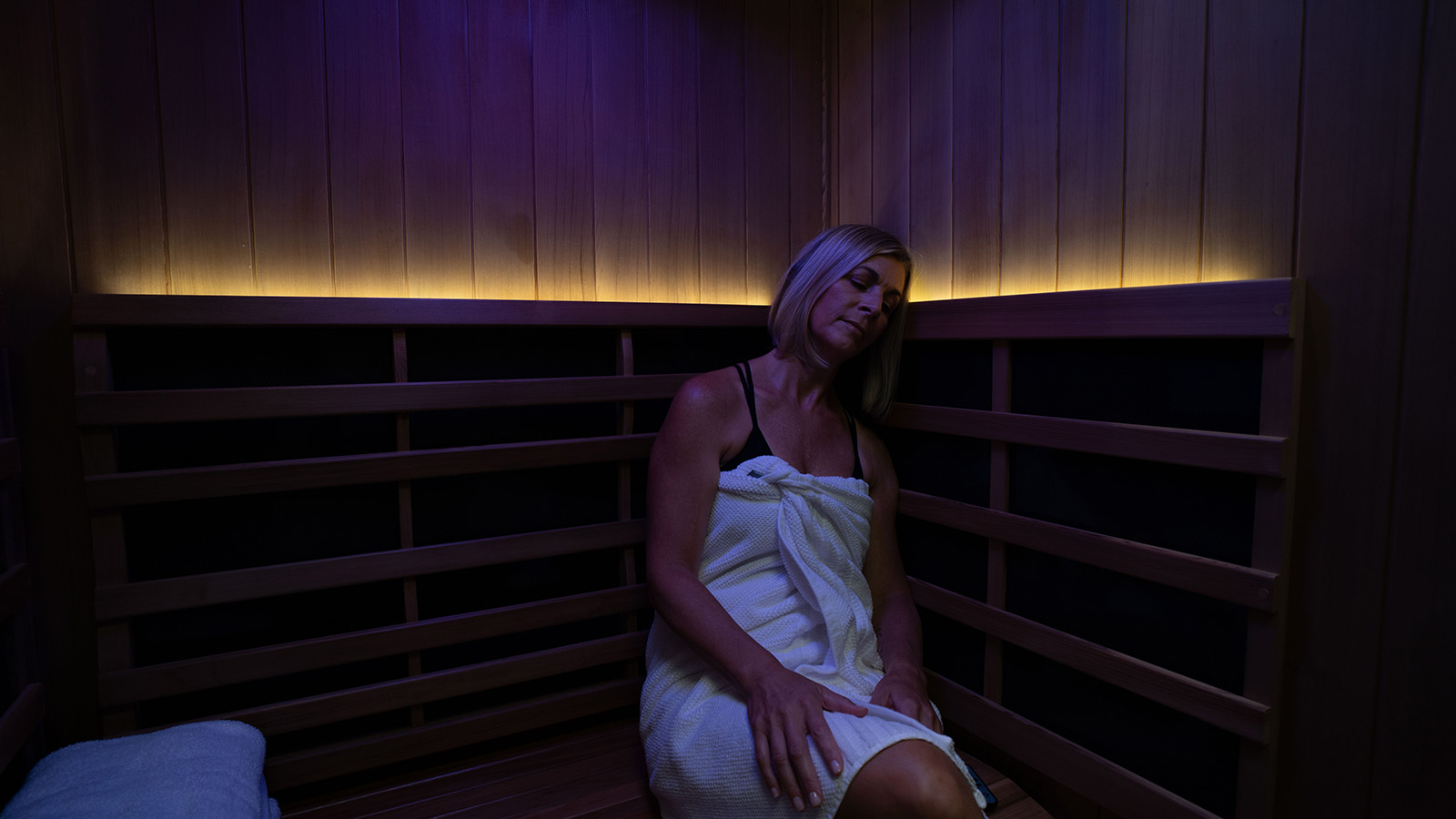
Detoxification
Infrared sauna therapy promotes deep detoxification by stimulating sweat production, which helps eliminate toxins from the body. The heat penetrates deeply into tissues, activating the body’s natural detox processes and purifying the skin and bloodstream. This process can lead to improved overall health and enhanced immune function.

Weight Loss
Infrared saunas can aid in weight loss by increasing the body’s core temperature and metabolic rate. The deep heat generated by infrared light encourages the body to burn calories, similar to a moderate workout. Regular sessions can help reduce localized fat and contribute to a leaner physique.

Pain Relief
Infrared sauna therapy offers significant pain relief by reducing inflammation and relaxing muscles. The deep heat helps to alleviate joint and muscle pain, making it an effective treatment for conditions such as arthritis, fibromyalgia, and general muscle soreness. This therapy also promotes faster recovery from injuries.
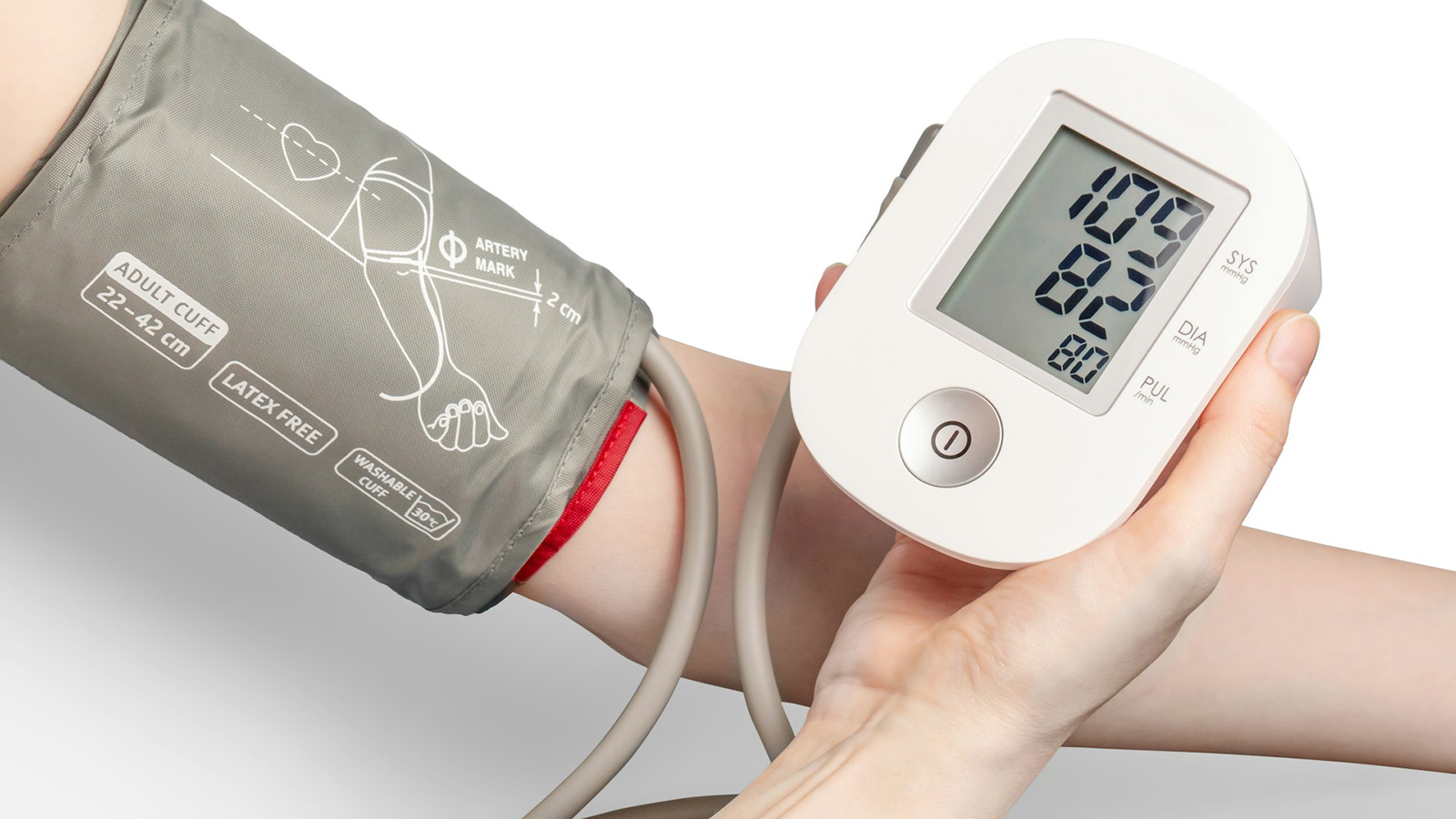
Cardiovascular Health
Using an infrared sauna can improve cardiovascular health by enhancing circulation and lowering blood pressure. The heat causes blood vessels to dilate, improving blood flow and oxygenation throughout the body. This process can strengthen the cardiovascular system and support overall heart health.

Relaxation
The soothing heat and light settings of our infrared sauna promote deep relaxation, reducing stress and tension. This therapy helps to balance the nervous system, calm the mind, and enhance overall mental well-being. Regular sessions can lead to improved sleep quality and reduced anxiety.

Anti-Aging
Infrared sauna therapy supports anti-aging by promoting healthy skin and reducing the signs of aging. The deep heat stimulates collagen production, improving skin elasticity and reducing wrinkles. It also helps to purify and rejuvenate the skin, giving it a more youthful appearance.

Respiratory Health
Infrared sauna therapy can benefit respiratory health by easing conditions such as asthma and bronchitis. The heat helps to open airways, reduce inflammation, and improve overall lung function. This can lead to easier breathing and enhanced respiratory wellness.

Immune Support
Regular use of an infrared sauna can strengthen the immune system by enhancing circulation and promoting detoxification. This process supports the body’s natural defenses, helping to fight off infections and illnesses more effectively.
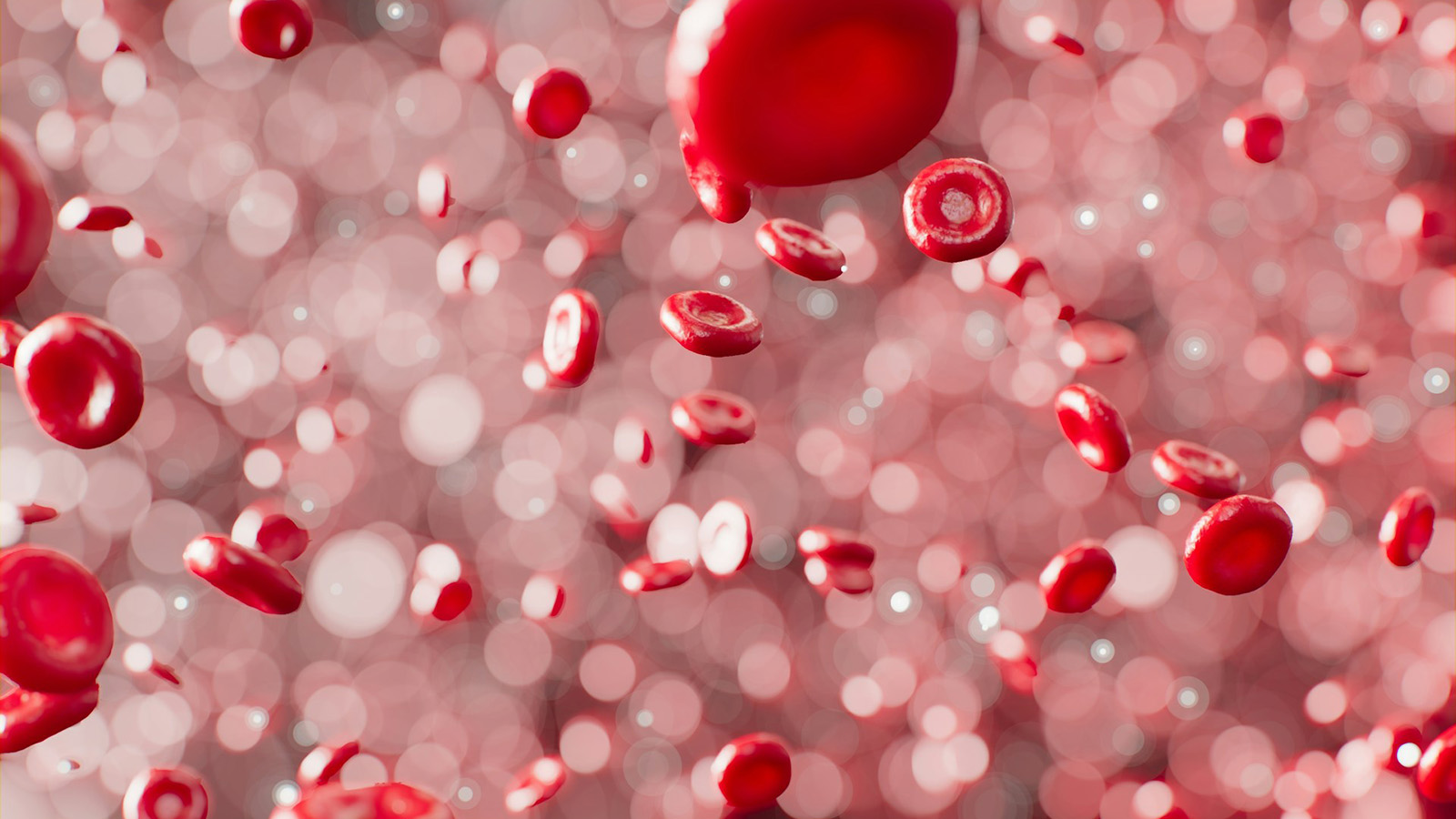
Improved Circulation
Infrared sauna sessions enhance blood flow and circulation, providing oxygen and nutrients to tissues and organs more efficiently. This improvement in circulation can lead to better overall health, increased energy levels, and faster healing of injuries.
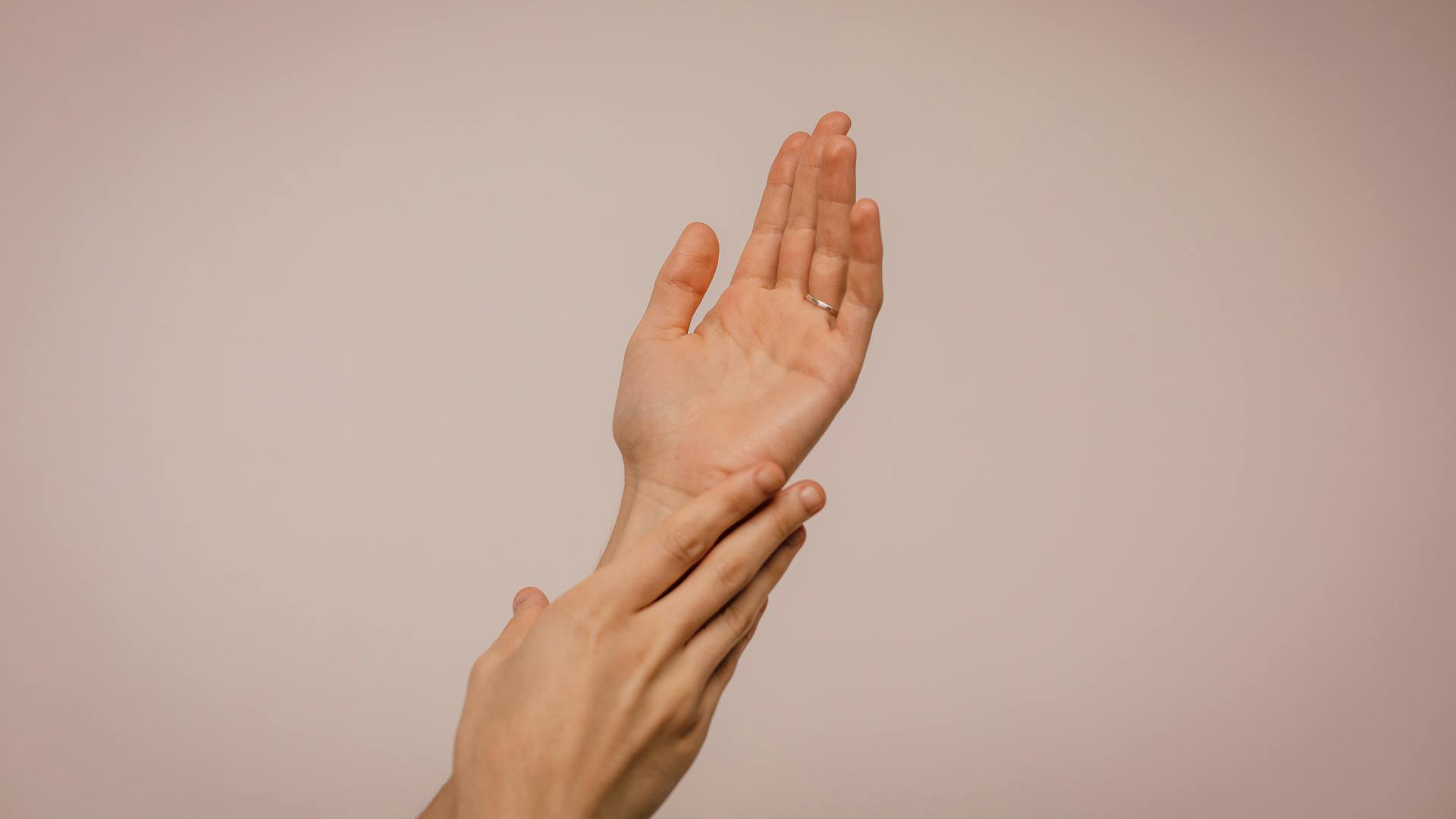
Skin Health
The infrared sauna supports skin health by promoting detoxification and stimulating skin cells. This leads to clearer, more radiant skin, as well as reduced acne and other skin conditions. Regular use can also help to maintain a youthful appearance by improving skin tone and texture.
Frequently Asked Questions About Infrared Sauna
How long are infrared sauna sessions?
Are infrared saunas like traditional steam saunas?
What are the benefits of infrared saunas?
How should I prepare for my infrared sauna experience?
Who cannot use the infrared sauna?
What can I do in the infrared sauna?
What do I do before and after my sauna session?
What do I wear inside the infrared sauna?
Recent Infrared Sauna News & Research
Infrared Sauna at Extivita: A Path to Wellness
At Extivita, we strive to offer therapies that enhance your well-being from the inside out. One such offering is our infrared sauna therapy—a soothing, science-backed wellness tool designed to promote detoxification, relaxation, and improved...
Kelly Family Commits $1 Million to Transformative Athletic Training and Recovery Space for LSU Student-Athletes
Extivita services are accessible and offer athletes hyperbaric oxygen therapy and infrared sauna to improve their overall abilities and athletic performances. Many athletes notice the positive effects and overall performance improvements after only...
Infrared sauna as exercise-mimetic? Physiological responses to infrared sauna vs exercise in healthy women: A randomized controlled crossover trial
Abstract Background: Passive heat therapies have been reported to have similar effects on the cardiovascular system as exercise. Studies supporting these findings in healthy populations have predominantly been done with men using warm water...
References:
- Crinnion, Walter J. “Sauna as a Valuable Clinical Tool for Cardiovascular, Autoimmune, Toxicant- Induced and Other Chronic Health Problems.” Environmental Medicine, 2011, p. 11.
- Schieke, Stefan M., et al. “Cutaneous Effects of Infrared Radiation: From Clinical Observations to Molecular Response Mechanisms.” Photodermatology, Photoimmunology & Photomedicine, vol. 19, no. 5, Oct. 2003, pp. 228–34. PubMed, doi:10.1034/j.1600-0781.2003.00054.x.
- Kauppinen, K. “Sauna, Shower, and Ice Water Immersion. Physiological Responses to Brief Exposures to Heat, Cool, and Cold. Part I. Body Fluid Balance.” Arctic Medical Research, vol. 48, no. 2, Apr. 1989, pp. 55–63.
- Kukkonen-Harjula, K., et al. “Haemodynamic and Hormonal Responses to Heat Exposure in a Finnish Sauna Bath.” European Journal of Applied Physiology and Occupational Physiology, vol. 58, no. 5, 1989, pp. 543–50. PubMed, doi:10.1007/BF02330710.
- Vuori, I. “Sauna Bather’s Circulation.” Annals of Clinical Research, vol. 20, no. 4, 1988, pp. 249–56.
- Hasan, J., et al. “Special Review. I. Physiological Effects of Extreme Heat as Studied in the Finnish ‘Sauna’ Bath.” American Journal of Physical Medicine, vol. 45, no. 6, Dec. 1966, pp. 296-314 contd.
- Kauppinen, K., et al. “Some Endocrine Responses to Sauna, Shower and Ice Water Immersion.” Arctic Medical Research, vol. 48, no. 3, July 1989, pp. 131–39.
- Cho, Soyun, et al. “Effects of Infrared Radiation and Heat on Human Skin Aging in Vivo.” Journal of Investigative Dermatology Symposium Proceedings, vol. 14, no. 1, Aug. 2009, pp. 15–19. ScienceDirect, doi:10.1038/jidsymp.2009.7.
- Sears, Margaret E., et al. “Arsenic, Cadmium, Lead, and Mercury in Sweat: A Systematic Review.” Journal of Environmental and Public Health, vol. 2012, 2012. PubMed Central, doi:10.1155/2012/184745.
- Ross, Gerald H., and Marie C. Sternquist. “Exposure and Chronic Illness in Police Officers: Significant Improvement with Sauna-Based Detoxification Therapy.” Toxicology and Industrial Health, vol. 28, no. 8, Sept. 2012, pp. 758–68. PubMed, doi:10.1177/0748233711425070.
- Hüppe, Michael, et al. Treatment of Patients Burdened with Lipophilic Toxicants: A Randomized Controlled Trial. no. 3, 2009, p. 9.
- Laukkanen, Jari A., and Tanjaniina Laukkanen. “Sauna Bathing and Systemic Inflammation.” European Journal of Epidemiology, vol. 33, no. 3, Mar. 2018, pp. 351–53. Springer Link, doi:10.1007/s10654-017-0335-y.
- Kunutsor, Setor K., et al. “Longitudinal Associations of Sauna Bathing with Inflammation and Oxidative Stress: The KIHD Prospective Cohort Study.” Annals of Medicine, vol. 50, no. 5, Taylor & Francis, July 2018, pp. 437–42. Taylor and Francis+NEJM, doi:10.1080/07853890.2018.1489143.
- Yu, Shi-Yau, et al. “Biological Effect of Far-Infrared Therapy on Increasing Skin Microcirculation in Rats.” Photodermatology, Photoimmunology & Photomedicine, vol. 22, no. 2, Apr. 2006, pp. 78–86. PubMed, doi:10.1111/j.1600-0781.2006.00208.x.
- Biro, Sadatoshi, et al. “Clinical Implications of Thermal Therapy in Lifestyle-Related Diseases.” Experimental Biology and Medicine, vol. 228, no. 10, Nov. 2003, pp. 1245–49. DOI.org (Crossref), doi:10.1177/153537020322801023.
- Oosterveld, Fredrikus G. J., et al. “Infrared Sauna in Patients with Rheumatoid Arthritis and Ankylosing Spondylitis. A Pilot Study Showing Good Tolerance, Short-Term Improvement of Pain and Stiffness, and a Trend towards Long-Term Beneficial Effects.” Clinical Rheumatology, vol. 28, no. 1, Jan. 2009, pp. 29–34. PubMed, doi:10.1007/s10067-008-0977-y.
- Beever, Richard. “Do Far-Infrared Saunas Have Cardiovascular Benefits in People with Type 2 Diabetes?” Canadian Journal of Diabetes, vol. 34, no. 2, Jan. 2010, pp. 113–18. ScienceDirect, doi:10.1016/S1499-2671(10)42007-9.
- Masuda, Akinori, et al. “The Effects of Repeated Thermal Therapy for Patients with Chronic Pain.” Psychotherapy and Psychosomatics, vol. 74, no. 5, 2005, pp. 288–94. PubMed, doi:10.1159/000086319.
- Gale, George D., et al. “Infrared Therapy for Chronic Low Back Pain: A Randomized, Controlled Trial.” Pain Research and Management, vol. 11, no. 3, 2006, pp. 193–96. DOI.org (Crossref), doi:10.1155/2006/876920.
- Beever, Richard. “Far-Infrared Saunas for Treatment of Cardiovascular Risk Factors.” Canadian Family Physician, vol. 55, no. 7, July 2009, pp. 691–96.
- Kihara, Takashi, Sadatoshi Biro, Yoshiyuki Ikeda, et al. “Effects of Repeated Sauna Treatment on Ventricular Arrhythmias in Patients with Chronic Heart Failure.” Circulation Journal: Official Journal of the Japanese Circulation Society, vol. 68, no. 12, Dec. 2004, pp. 1146–51. PubMed, doi:10.1253/circj.68.1146.
- Kihara, Takashi, Sadatoshi Biro, Masakazu Imamura, et al. “Repeated Sauna Treatment Improves Vascular Endothelial and Cardiac Function in Patients with Chronic Heart Failure.” Journal of the American College of Cardiology, vol. 39, no. 5, Mar. 2002, pp. 754–59. PubMed, doi:10.1016/s0735-1097(01)01824-1.
- Kihara, Takashi, Masaaki Miyata, et al. “Waon Therapy Improves the Prognosis of Patients with Chronic Heart Failure.” Journal of Cardiology, vol. 53, no. 2, Apr. 2009, pp. 214–18. PubMed, doi:10.1016/j.jjcc.2008.11.005.
- Miyata, Masaaki, et al. “Beneficial Effects of Waon Therapy on Patients with Chronic Heart Failure: Results of a Prospective Multicenter Study.” Journal of Cardiology, vol. 52, no. 2, Oct. 2008, pp. 79–85. PubMed, doi:10.1016/j.jjcc.2008.07.009.
- Kikuchi, Hiroshi, et al. “Effect of Repeated Waon Therapy on Exercise Tolerance and Pulmonary Function in Patients with Chronic Obstructive Pulmonary Disease: A Pilot Controlled Clinical Trial.” International Journal of Chronic Obstructive Pulmonary Disease, vol. 9, Dec. 2013, pp. 9–15. PubMed Central, doi:10.2147/COPD.S50860.
- Umehara, Megumi, et al. “Repeated Waon Therapy Improves Pulmonary Hypertension during Exercise in Patients with Severe Chronic Obstructive Pulmonary Disease.” Journal of Cardiology, vol. 51, no. 2, Elsevier, Apr. 2008, pp. 106–13. www.journal-of-cardiology.com, doi:10.1016/j.jjcc.2008.01.004.
- Johnstone, Daniel M., et al. “Turning On Lights to Stop Neurodegeneration: The Potential of Near Infrared Light Therapy in Alzheimer’s and Parkinson’s Disease.” Frontiers in Neuroscience, vol. 9, 2015, p. 500. PubMed, doi:10.3389/fnins.2015.00500.
- Laukkanen, Tanjaniina, et al. “Sauna Bathing Is Inversely Associated with Dementia and Alzheimer’s Disease in Middle-Aged Finnish Men.” Age and Ageing, vol. 46, no. 2, Mar. 2017, pp. 245–49. Silverchair, doi:10.1093/ageing/afw212.
- Mero, Antti, et al. “Effects of Far-Infrared Sauna Bathing on Recovery from Strength and Endurance Training Sessions in Men.” SpringerPlus, vol. 4, July 2015. PubMed Central, doi:10.1186/s40064-015-1093-5.
- Noponen, Perttu, et al. “Effects of Far Infrared Heat on Recovery in Power Athletes.” Journal of Athletic Enhancement, vol. 04, Jan. 2015. ResearchGate, doi:10.4172/2324-9080.1000202.
- Lee, Ju Hee, et al. “Effects of Infrared Radiation on Skin Photo-Aging and Pigmentation.” Yonsei Medical Journal, vol. 47, no. 4, Aug. 2006, pp. 485–90. PubMed Central, doi:10.3349/ymj.2006.47.4.485.
- Tanaka, Yohei, et al. “Long-Term Evaluation of Collagen and Elastin Following Infrared (1100 to 1800 Nm) Irradiation.” Journal of Drugs in Dermatology: JDD, vol. 8, no. 8, Aug. 2009, pp. 708–12.
- —. “Objective Assessment of Skin Rejuvenation Using Near-Infrared 1064-Nm Neodymium: YAG Laser in Asians.” Clinical, Cosmetic and Investigational Dermatology, vol. 4, July 2011, pp. 123–30. PubMed Central, doi:10.2147/CCID.S22841.
- Matsumoto, Shuji, et al. “Effects of Thermal Therapy Combining Sauna Therapy and Underwater Exercise in Patients with Fibromyalgia.” Complementary Therapies in Clinical Practice, vol. 17, no. 3, Aug. 2011, pp. 162–66. ScienceDirect, doi:10.1016/j.ctcp.2010.08.004.
- Matsushita, Kakushi, et al. “Efficacy of Waon Therapy for Fibromyalgia.” Internal Medicine (Tokyo, Japan), vol. 47, no. 16, 2008, pp. 1473–76. PubMed, doi:10.2169/internalmedicine.47.1054.
- Saunas and Lyme Disease – Ozone, FIR, Steam, Dry Heat. https://lymebook.com/sauna-for-lyme-disease.htm. Accessed 1 Apr. 2021.

